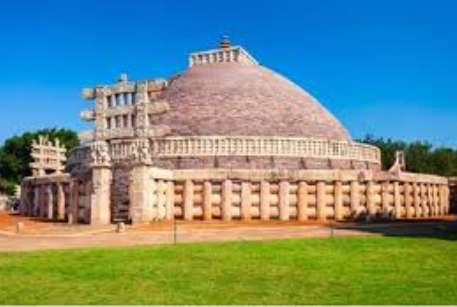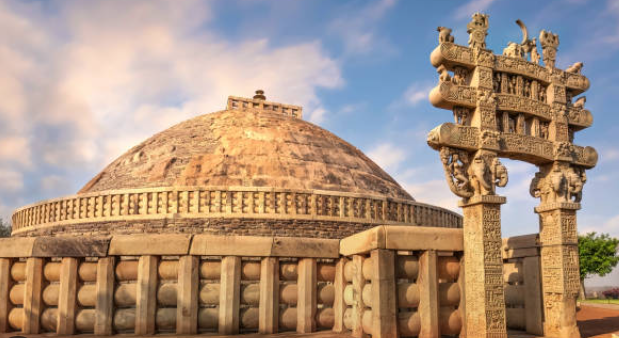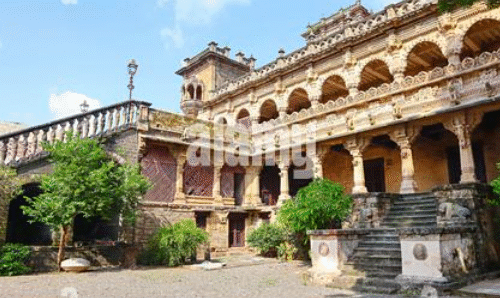Sanchi Fort stands tall and silent on a hill in Madhya Pradesh, India. It watches over the town of Sanchi like a guardian of ancient stories. Though the famous Great Stupa nearby often draws more attention, Sanchi Fort holds a deep charm of its own. It speaks softly through its stones and ruins, telling stories of kings, warriors, and ancient architects. Today, it invites travelers, history lovers, and curious minds to explore its old walls and forgotten corners.
History of Sanchi Fort
The exact origin of Sanchi Fort remains a mystery. While nearby monuments like the Great Stupa have well-recorded histories, the fort’s background is less clear. Many believe the fort was built during the Gupta period around the 4th century CE. Others think it came later, possibly during medieval times when many such hill forts were constructed for defense. Despite this uncertainty, one thing is clear—Sanchi Fort played an important role in the history of this region.
Over time, several rulers controlled the area. Each ruler brought changes, both in design and in the use of the fort. The fort may have served as a lookout point, a royal residence, or a military base. It stood through many dynasties and saw cultural shifts, wars, and peace. Its stone walls have felt the passage of time, but they still hold the strength and grace of their builders.
Location of Sanchi Fort
Sanchi Fort is located in the Raisen district of Madhya Pradesh. It sits about 45 kilometers northeast of Bhopal, the state capital. The fort rests on a small hill, offering wide views of the landscape below. This location was perfect for defense. Soldiers could watch the area for miles around and stay safe from sudden attacks.
Chanderi Fort – A Silent Story of History and Bravery
Besides safety, the location also gave the fort a peaceful and spiritual feel. The view of the fields, hills, and other ancient buildings creates a beautiful and calm atmosphere. The fort’s surroundings include many Buddhist sites, giving visitors a complete historic experience. Today, visitors reach Sanchi Fort easily by road. The short uphill walk to the fort rewards them with history and scenery.
Design and Structure of Sanchi’s Fort
The design of Sanchi Fort shows the builders’ smart thinking and skill. Though parts of the fort are now in ruins, the main structure remains strong. Thick stone walls surround the area, and a large gateway welcomes visitors inside.
Inside the fort, there are remains of temples, halls, and old rooms. Open courtyards were likely used for gatherings and prayers. Some parts were built to house the ruling family or soldiers. The entire fort was planned with care—making it both a safe place and a working center for the people living there.

Many paths and narrow walkways connect different sections. The builders also planned for natural light and air, using open areas and large doorways. This made the fort comfortable to live in, even during hot summers.
Architectural Features
Sanchi Fort reflects a mix of ancient Indian styles. The builders used local stone and simple tools, but their designs show great creativity. The walls, arches, and pillars are mostly plain, but some still carry carvings. These small designs often show daily life, animals, or sacred symbols.
You can also spot parts that show Buddhist influence, linking the fort with the spiritual life of Sanchi town. Though the fort was built more for protection than decoration, its beauty lies in its simplicity and planning.
Some doorways are wide and high, allowing horses or elephants to pass. The stairs are strong and wide, built for both people and supplies. The fort also has small watchtowers or points where guards could stand. These features give us a clear idea of how the fort served both rulers and common people.
Attractions Within and Around Sanchi Fort
Sanchi Fort itself is a major attraction, but the area around it offers even more. The most famous nearby monument is the Great Stupa, a Buddhist structure built by Emperor Ashoka in the 3rd century BCE. It draws visitors from all over the world.
Close to the fort, you can explore smaller stupas, old temples, and stone pillars. The Ashoka Pillar is one such famous spot. Its carvings are well preserved and show the art style of that time. The nearby Sanchi Archaeological Museum is also worth a visit. It holds tools, idols, and items found in the area.
Inside the fort, you can see ancient staircases, domes, and remains of prayer halls. Walking through the fort feels like walking back in time. Each stone and pillar seems to whisper an old story.
Visiting Sanchi Fort
Visiting Sanchi Fort is easy. From Bhopal, you can take a bus, car, or taxi. The best time to visit is from October to March when the weather is cool and pleasant. During this time, the green surroundings and soft sun make the trip more enjoyable.
Wear light clothes and good walking shoes. The walk up the hill is not too hard, but the paths are uneven. Bring water and a hat for sunny days. Local guides are often available, and they can tell you more about the fort’s history and nearby places.
Try to visit in the early morning or late afternoon. The sunrise and sunset from the fort are truly beautiful. You’ll also find fewer people at these times, making your visit more peaceful.
Conclusion
Sanchi Fort may not be as popular as the Great Stupa, but it holds equal charm and history. It combines ancient design, strategic planning, and peaceful surroundings. It tells the story of a region that once played a key role in Indian history.
For travelers who love hidden gems, Sanchi Fort offers a calm yet rich experience. You can explore ruins, learn stories, and enjoy nature all in one place. The fort, along with the surrounding historical sites, makes Sanchi a perfect destination for a day trip or weekend getaway.
Step into the past, feel the silence of stone walls, and walk where kings and monks once walked. Sanchi Fort is waiting to share its story with you. Read More




